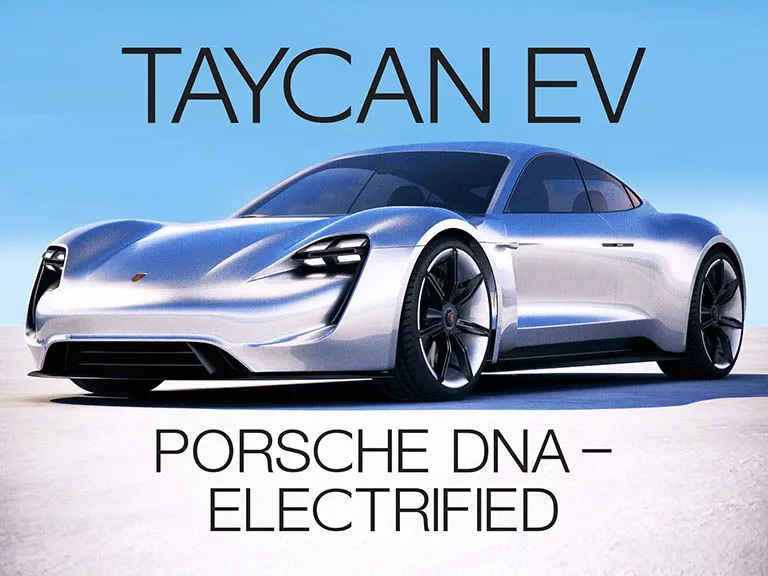
There are 30,000 pre-orders for the Porsche Taycan EV, arriving this September
July, 2019: Porsche has published an update on the company’s first pure electric vehicle, the Taycan EV, which will be presented on September 4 and be released shortly thereafter. The cheapest of four planned variants is expected to cost around 90,000 euros. For this price, owners get a battery with a capacity of 80 kWh and an electric motor at the rear axle that is supposed to deliver between 240 and 280 kW. The base Porsche EV’s possible designation is Taycan S.
By John Coulter, CMO, Current EV
There are 30,000 pre-orders for the Taycan, 10,000 more than previously reported. The high interest forced Porsche to expand its production capacity from 20,000 to 40,000 Taycans. Due to the massive response, potential customers have been offered an option program for moving up on the list if they increase their down payment to 2,500 euros.
The top model Taycan will have two electric motors with 160 kW on the front axle and 300 kW on the rear axle, and a max range of 500 kilometers (310 miles).
Thanks to the vehicle’s 800-volt architecture, re-charging for 100 kilometres of energy will take about four minutes at a correspondingly high power charging station. Taycan’s DC charging capacity will be 250 kW. The automaker will employ 1,400 people to assist with Taycan’s production at the Porsche factory in Stuttgart Zuffenhausen. Following the concept of “smart, lean, green”, Porsche is pursuing resource-friendly production. The Taycan production process is CO2 neutral. The future goal at Zuffenhausen is to establish a complete zero-impact factory, with no environmental impact whatsoever.
More than a thousand new staff members have been hired. It’s the broadest re-training operation in the company’s history. Qualification can take up to six months with 45 different paths to choose from and built from 350 training modules. This requires Porsche to reserve whole halls for the courses to make future employees fit for various roles.
The Taycan will be assembled on a “Flexi-Line.” Porsche says humans remain central to the process. 400 remaining positions are being filled; the company says it has 32,000 applicants.
The German automaker has previously announced it would double its investment in plug-in hybrids and pure EVs by 2022 to more than 6 billion euros ($7.43 billion). Their goal, not stated, but implicit, is to create e-cars that can outshine and outsell Tesla.
Porsche’s Mission E (see their website), takes the company on its next step to the future, defining the automaker’s complete vision of all-electric driving. Porsche says these components are essential: “4 individual seats, 4 doors, 2 luggage compartments, electric drive (E-Performance, Porsche style). Integrated in a harmonious overall concept. Concept Study Mission E sets the stage for tomorrow. With its design and its technology, it provides answers to the question of the sports car of the future.”
In creating the Taycan, Porsche engineers had these design stipulations in mind;
- Acceleration 0-100 km/h (0-62 mph) – 3.5 sec
Acceleration 0-200 km/h (0-124 mph) – 12 sec - Top speed – 250 km/h (155 mph)
- Power – 440 kW (600 hp)
- Range – 500 km (300 Miles)
- System voltage – 800 V
- Charging time – 80% in 15 min
Whether these metrics will be attained or not in the final product won’t be known until the car’s release.
What does the word “Taycan” mean? Says Porsche: “In the final stretch, the marketing experts select their favorite names, assembling a list to be presented to the assembled board in the autumn of 2017. The decision is made: Taycan. A name that fulfills every phonetic, legal, creative, strategic, and model-specific requirement. Composed of two terms of Turkic origin, this word can be roughly translated as “soul of a spirited young horse.” And that’s exactly what the first fully electric Porsche will be: lively, impetuous, vigorous, light-footed on long stretches without tiring, and free-spirited. The name reflects both the source and the future of the brand: the horse on the Porsche crest, the expression of its soul, on its way into a new era of the sports car. A perfect fit, too, with the slogan of the advertising campaign: “Soul, electrified.” Taycan also has positive associations in many of the world’s languages: in Japanese, for instance, taikan means roughly “physical experience”—driving in its most electrifying form.”
Porsche states: “In the Concept Study Mission E, principles come to bear which have actually been intrinsic to every Porsche since the birth of the 356 in 1948: lightness, openness, purism, clear architecture, driver-orientation and day-to-day usability. The all-electric drive concept allows an entirely new interpretation of these principles.”
Recent Posts
- The 2022 Audi Q4 e-Tron SUV combines performance, practicality and luxury
- Ford's 2022 F150 Lightning All-Electric Truck is in high demand
- Legendary Audi performance is at the heart of the 2022 Audi e-tron GT and its RS sibling.
- Meet the Lexus RZ 450e – the luxury brand’s 1st EV
- The 2022 GV60 is Genesis’ first all-electric vehicle

